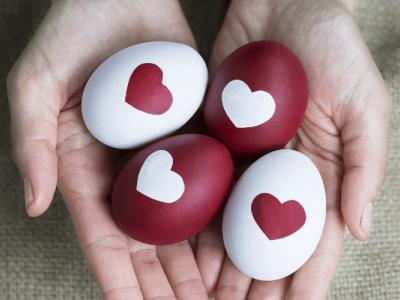Você está aqui
Cord Blood Banking for Babies Conceived with Egg or Sperm Donors
 Assisted reproductive technologies have opened doors for individuals to explore many different ways to build a family. For LGBTQ+ couples, single parents by choice, and heterosexual couples with an underlying fertility issue, conception using a sperm or egg donor may be the best way to have a baby that is biologically related to one of the parents. Parent’s Guide to Cord Blood recently described cord blood banking for the nontraditional family, which focused on families pursuing adoption or surrogacy1. In this article, we are diving deeper into the importance of cord blood banking for children conceived using a "gamete donor" that provided an egg or sperm.
Assisted reproductive technologies have opened doors for individuals to explore many different ways to build a family. For LGBTQ+ couples, single parents by choice, and heterosexual couples with an underlying fertility issue, conception using a sperm or egg donor may be the best way to have a baby that is biologically related to one of the parents. Parent’s Guide to Cord Blood recently described cord blood banking for the nontraditional family, which focused on families pursuing adoption or surrogacy1. In this article, we are diving deeper into the importance of cord blood banking for children conceived using a "gamete donor" that provided an egg or sperm.
Historically, most families that have used a gamete donor were heterosexual couples in which one member of the couple had an underlying fertility issue2. In the past couple of decades, LGBTQ+ couples and single parents have become a more prominent demographic pursuing this reproductive option. Disclosure to donor-conceived children regarding the nature of their conception is becoming more commonplace and accepted within this community3. However, in most cases, unless a family is working with a “known donor” (often a close friend or relative), children conceived through gamete donation typically have limited information about their donor, and no means to contact the donor until they reach the age of 184.
Thus, for those families that have conceived a child using an egg or sperm donor, the opportunity to bank newborn stem cells may prove to be an even more valuable resource. These children only have contact with half of their biological relatives until at least age 18. Banking cord blood provides potential access to medical therapies where matched stem cells are needed5. Due to ethical concerns and privacy policies held by many egg and sperm banks, it is unlikely that an egg or sperm donor would be asked to serve as a bone marrow donor for a donor-conceived child.
Moreover, families that have relied on gamete donation often have more than one child from the same donor. This means their children are full siblings to each other and have a good chance of providing each other with cord blood for medical therapies that accept sibling donors. The medical therapies that might rely on sibling cord blood include numerous cancers, blood disorders, and metabolic disorders that can be treated with cord blood transplants5,6. In addition, children with cerebral palsy or autism can receive therapy with sibling cord blood under an FDA-approved program7. Therefore, it is even more prudent for families conceiving via gamete donor to consider preserving newborn stem cells in case a need for it were to arise.
Cord Blood Registry (CBR) has a unique program which provides free cord blood banking to families if they conceive a child using an egg or sperm donor from one of their sister companies, either California Cryobank, or Donor Egg Bank USA. This program, called Cord Blood Advantage, includes free cord blood and cord tissue processing and one year of free storage. Families also have access to the CBR Customer Care and Clinical Specialist teams, and can have peace of mind knowing their newborn stem cells are being stored in their secure facility in Tucson, AZ.
There are many reasons to consider banking newborn stem cells, particularly in the context of non-traditional family building. It is important to speak with your healthcare provider regarding your options for cord blood and cord tissue collection, to help you and your family make an informed decision.
References:
- Parent’s Guide to Cord Blood Foundation. Cord blood banking for the nontraditional family. Dec. 2020 News. Published 2020-12-15
- Ferrara I, Ballet R, Grudzinskas JG. Intrauterine donor insemination in single women and lesbian couples: a comparative study of pregnancy rates. Human Reproduction 2000; 15(3):621-625.
- Harper JC, Kennett D, Reisel D. The end of donor anonymity: how genetic testing is likely to drive anonymous gamete donation out of business. Human Reproduction 2016; 31(6): 1135-1140.
- Interests, obligations, and rights in gamete and embryo donation: an Ethics Committee Opinion. Fertility and Sterility 2019; 111(4):664-670.
- Parent’s Guide to Cord Blood Foundation. Diseases Treated. Last modified 2020-07-23
- Screnci M, Murgi E, Valle V, Tamburini A, Pellegrini MG, et al. Sibling cord blood donor program for hematopoietic cell transplantation: the 20-year experience in the Rome Cord Blood Bank. Blood Cells, Molecules, and Diseases 2016; 57:71-73.
- Kurtzberg J. Clinical Trial Update: Cord Blood for Autism, Cerebral Palsy, Stroke & Cord Tissue for MIS-C. World Cord Blood Day Online Presentation Published 2020-11-17



 Lauren Isley is a Medical Science Liaison at Cord Blood Registry. She received her Masters of Science in Genetic Counseling from Wayne State University and has worked in various roles in the field of genetics, including several positions in assisted reproductive technologies and reproductive genetics. At CBR, Lauren pulls from her training as a genetic counselor and her experience with patients and healthcare professionals to provide education on the potential of newborn stem cells.
Lauren Isley is a Medical Science Liaison at Cord Blood Registry. She received her Masters of Science in Genetic Counseling from Wayne State University and has worked in various roles in the field of genetics, including several positions in assisted reproductive technologies and reproductive genetics. At CBR, Lauren pulls from her training as a genetic counselor and her experience with patients and healthcare professionals to provide education on the potential of newborn stem cells.